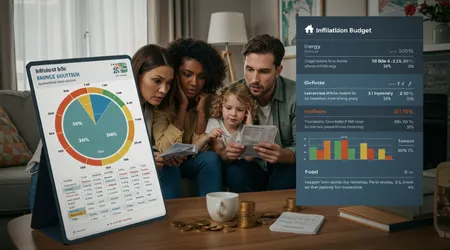Inflation in the UK: Latest ONS Data Explained for Households

Inflation in the UK has become a persistent concern for households, shaping budgets and influencing daily decisions in 2025.
The Office for National Statistics (ONS) recently released data showing the Consumer Prices Index (CPI) rose to 3.8% in July 2025, up from 3.6% in June, marking the highest rate since January 2024.
This uptick, driven by surging airfares and food prices, signals ongoing economic pressures that households must navigate.
For families already stretched thin, understanding these numbers isn’t just academic it’s a matter of survival.
This article unpacks the latest ONS data, offering clarity on how inflation in the UK affects you, with practical insights to manage its impact.
Why does this matter? Inflation erodes purchasing power, making everyday essentials like groceries and utilities pricier.
For a family in Manchester, a weekly shop that cost £100 two years ago now demands £150. The Bank of England’s 2% target feels distant as prices climb faster than expected, prompting questions about future interest rate decisions.
This piece explores the causes, consequences, and strategies for households, blending hard data with real-world examples to empower readers.
What’s Driving Inflation in the UK?
The latest ONS figures reveal inflation in the UK at 3.8% in July 2025, fueled primarily by a 30.2% surge in airfares, the largest July increase since 2001.
School holidays shifted earlier, inflating travel costs as families booked summer trips. Unlike last year, fuel prices barely dipped, adding to the strain.
Food prices also climbed, with a 4.9% rise in July, the highest since February 2024. Beef, chocolate, and instant coffee led the charge, driven by global supply chain issues and domestic cost pressures.
++ UK Economy 2025: Key Indicators to Watch This Quarter
For a London-based teacher, this means a tighter grocery budget, forcing tough choices between quality and quantity.
Policy changes, like April’s National Insurance Contribution hikes, have compounded costs for businesses, which pass these onto consumers.
Climate-driven supply disruptions further inflate food prices, hitting households hard. The question looms: can families keep up with these relentless price hikes?

How Inflation Impacts Different Households
Low-income households face a harsher reality, with the ONS reporting a 4.1% cost-of-living rise for them in June 2025, compared to 3.8% for wealthier households.
Essentials like rent and energy consume a larger share of their income, leaving little room for savings. A single parent in Birmingham, for instance, might skip meals to afford school uniforms.
Private renters endure the highest inflation rate at 4.5% in June, driven by soaring rental payments. In contrast, high-income households, buoyed by faster wage growth, feel less pinch. This disparity highlights a growing economic divide, where the poorest bear the brunt.
Middle-income families aren’t immune either. A 1.6% drop in disposable income in July, per Asda’s Income Tracker, marks their first decline in two years.
For a nurse in Leeds, this could mean delaying a car repair, illustrating inflation’s ripple effects across society.
The Bank of England’s Response and Its Ripple Effects
The Bank of England, tasked with a 2% inflation target, cut interest rates to 4% in August 2024, aiming to spur spending. Yet, with inflation in the UK rising, further cuts may slow.
Higher interest rates earlier pushed mortgage repayments up, squeezing homeowners. A Bristol couple, for example, saw their monthly payment jump £200, forcing budget cuts.
This delicate balance curbing inflation without stifling growth challenges policymakers. The Bank’s 5-4 vote on the latest cut signals caution, as inflation is projected to peak at 4% in September. Households face uncertainty as borrowing costs linger.
Read more: Nearly One in Five NHS Doctors Considering Going Abroad Amid Pay and Training Frustrations
Rising unemployment, at 4.7% in July 2025, adds complexity. Fewer job vacancies (718,000 from May to July) suggest businesses are hesitant to invest, potentially worsening economic strain. Will the Bank prioritize growth or price stability in this tightrope walk?
Practical Strategies for Households to Cope
Households can counter inflation in the UK by adopting savvy financial habits. Budgeting apps like Moneyhub help track spending, revealing areas to cut, like unused subscriptions. A Cardiff family saved £50 monthly by ditching streaming services they rarely used.
Bulk-buying non-perishables during sales can offset food price hikes. Shopping at discount retailers or local markets also stretches budgets. Energy-saving measures, like LED bulbs or shorter showers, reduce utility bills, critical as Ofgem’s price cap rises.
For renters, negotiating lease terms or exploring shared housing can ease costs. Long-term, investing in skills training boosts earning potential, offering a buffer against inflation’s bite. Proactive steps empower households to regain control.
Another approach involves meal planning to curb food waste. A Liverpool chef, for instance, plans weekly menus around discounted items, saving £20 weekly. Small adjustments like these accumulate, providing relief amidst rising costs.
Seeking fixed-rate utility deals locks in prices, shielding against energy spikes. Households should also review insurance or broadband contracts for better rates, ensuring every pound stretches further in this inflationary climate.
The Broader Economic Context
Globally, inflation in the UK aligns with trends in the US (2.7% in July) and Eurozone (2.1% in August). The European Central Bank’s rate cuts to 2% reflect similar pressures. Yet, UK-specific factors, like Brexit-related trade costs, amplify price pressures.
The ONS notes services inflation at 5.0% in July, driven by domestic costs like wages. This stickiness complicates the Bank’s efforts to tame inflation without harming jobs. Households feel this in rising service costs, from haircuts to dining out.
Historical context underscores the challenge. Inflation hit 11.1% in October 2022, a 41-year high, before easing. Today’s 3.8% feels manageable but still outpaces wage growth for many, squeezing real incomes. The road ahead remains bumpy.
| Category | Inflation Rate (July 2025) | Key Drivers |
|---|---|---|
| Overall CPI | 3.8% | Airfares, food prices |
| Food & Non-Alcoholic Drinks | 4.9% | Beef, chocolate, instant coffee |
| Housing & Household Services | 6.2% | Rent, energy costs |
| Transport | 3.2% | Airfares, fuel prices |
| Core Inflation | 3.8% | Excludes energy, food |
Source: Office for National Statistics (ONS), July 2025
Looking Ahead: What’s Next for UK Households?
The Bank of England forecasts inflation peaking at 4% in September 2025, twice its target. This projection, coupled with rising energy costs, signals tougher months ahead. Households must brace for higher utility bills as winter looms.
Government policies, like the April 2025 National Living Wage increase, aim to boost incomes but risk fueling further price rises. A Sheffield baker, for example, raised pastry prices to cover higher staff costs, illustrating this cycle.
Long-term relief hinges on global stability. Easing supply chain disruptions or energy price drops could soften inflation. Until then, households must adapt, balancing immediate needs with future financial security.
Conclusion: Navigating the Inflation Storm
Inflation in the UK remains a formidable challenge, reshaping how households manage money in 2025. The ONS data paints a clear picture: at 3.8%, inflation outstrips the Bank of England’s 2% target, driven by airfares, food, and rent.
Like a river carving through rock, inflation erodes budgets slowly but relentlessly, especially for low-income families. Yet, households aren’t helpless.
Smart budgeting, strategic shopping, and energy-saving habits can blunt its impact. As the Bank navigates this economic tightrope, families must stay proactive, asking: how can we stretch our pounds further?
By understanding these dynamics and acting decisively, UK households can weather this storm with resilience.
Frequently Asked Questions
1. Why is inflation higher for low-income households?
Low-income households spend more of their income on essentials like food and energy, which face higher inflation rates (e.g., 4.1% vs. 3.8% for high-income households in June 2025).
2. How can I reduce my grocery bill during inflation?
Plan meals around sales, buy in bulk, and shop at discount stores. A Liverpool family saved £20 weekly by focusing on discounted ingredients.
3. Will interest rates rise again soon?
The Bank of England’s cautious approach suggests slower rate cuts, but a September 2025 peak at 4% inflation may delay further reductions.
4. How does UK inflation compare globally?
At 3.8% in July 2025, UK inflation exceeds the Eurozone’s 2.1% but aligns closely with the US’s 2.7%, per ONS and international data.
5. What’s the best way to save on energy costs?
Switch to LED bulbs, reduce appliance use, and lock in fixed-rate tariffs. A Cardiff household cut bills by £50 monthly with these steps.
Sources: Office for National Statistics (ONS), August 2025; Bank of England Monetary Policy Report, August 2025
